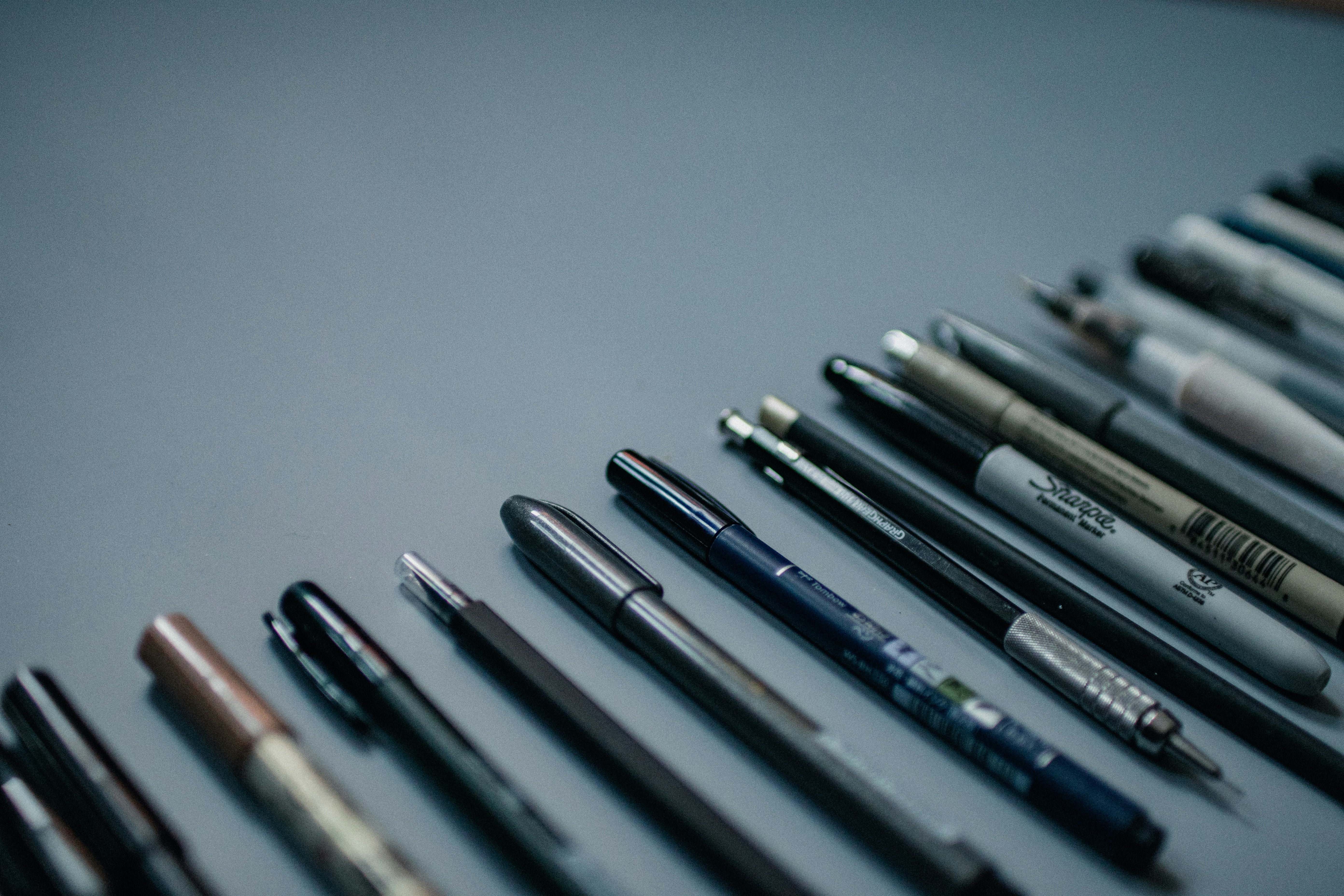
What’s in My Studio? Tools I Can’t Live Without
By Hansheng Lee – Lee Hansheng Studios | Art Collective International
Photo Credit: Kelly Sikkema
My studio isn’t flashy. It’s not filled with the most expensive equipment or trending gear. But it’s layered with meaning—tools worn soft from years of use, brushes that know the rhythm of my hand, and scraps that somehow always find their way into something beautiful.
Every artist’s studio is a little world, and mine is no different. It’s a space of exploration, meditation, experimentation, and sometimes chaos. It smells like paint, ink, the occasional herbal infusion, and fresh-cut paper. It’s where ideas are born—and sometimes where they patiently wait to bloom.
At Lee Hansheng Studios, my creative work is split between two dedicated spaces. The upstairs studio is where all 2D and digital work happens—watercolors, ink, gouache, and digital illustrations are created here, often surrounded by sketchbooks, reference materials, a mini library, and the quiet hum of inspiration. The downstairs studio is reserved for larger-scale work like stained glass, resin, and expansive paintings that need room to breathe. For this blog, we’ll be focusing on the heart of Lee Hansheng Studios: the 2D upstairs space where most of my fine art and digital storytelling takes shape.
Today, I’m sharing a look at the tools I return to over and over again—my essentials. Some are practical, some sentimental, all essential to the way I work.
🖌️ My Favorite Brushes (Watercolor, Acrylic, and Sumi-e)
I have drawers full of brushes, but only a handful that I use constantly.
-
Sable and synthetic round brushes for watercolor—perfect for delicate washes and detail work. I've been really partial to my Escoda brushes recently, and I always have a few squirrel hair brushes as well.
-
Mop and quill brushes for loose backgrounds and cloudscapes.
-
Flat and filbert brushes for acrylic work, especially for blocking in shapes or layering texture.
-
Chinese and Japanese ink brushes for Sumi-e bookmarks or expressive linework—soft-bodied, expressive, and deeply responsive.
Some of these brushes cost under $2. Others were $40+. Each serves its purpose, and I love having a mix of both. It took me well over 20 years to have all of the brushes I have now, so it's not a race. Having a few good high quality brushes (they don't have to be expensive, they just have to be multi purpose, thats the important part).
✏️ Pencils, Pens & Mark-Makers
The sketchbook stage is sacred—and these tools are always nearby:
-
Tül Mechanical Pencils (0.7mm) – smooth, sleek, and reliable.
-
Mechanical pencil (0.5mm) – for fast structure or detail sketching.
-
Micron pens – archival ink, great for outlines or botanical pieces.
-
Ohuhu Liner Pens – also archival ink, various sizes and tips
-
Kuretake brush pens – expressive inking for calligraphy or fluid sketching.
-
White gel pen – for highlights and final touches on toned paper.
-
Charcoal & chalk pencils – especially for moody figure work or layered sketches.
-
Zebra Brush Pens (all 3 sizes)– a very solid controlled tip, smooth ink, permanent.
- Pilot Brush Pen (refillable) – refillable, balanced weight, and easy to travel with.
I have a literal wall of cubes full of markers, pens, ink refills, knives, scissors, and other items that I use almost regularly.
🎨 Paints & Pigments
I’ve built up a collection over the years, but there are a few go-to brands and pigments I constantly reach for:
-
Watercolors: Kuretake, Yasutomo, Daniel Smith, Boku-undo, Artistro
- I have also been getting into hand made watercolors recently, and used to make them myself, slowly getting back into that process (will share more in a different post)
-
Favorites: Dioxazine Purple, Prussian Blue, Green Gold, Lunar Black, and Permanent Rose.
-
Acrylics: Golden and Liquitex—especially for thicker layers and sculptural effects, or a looser flowing, but still solid medium.
-
Inks: Sumi ink for calligraphy and brushwork, white acrylic ink for highlights.
-
Gouache: Holbein for matte, punchy color layering—great for hybrid pieces.
- Poster Paint: Not American poster paint! I'm talking about Japanese/ German poster paint, Pilot and Sakura make a decent one. (I will go into detail on this in another post as well). You can use it as watercolor or gouache and layer them seamlessly regardless of the concentration.
📜 Paper & Surfaces
I’m particular about my paper. The texture, weight, and edge all matter depending on the project.
-
Watercolor paper: Arches, Fluid 100, and handmade cotton rag with deckled edges.
-
Sketchbooks: I have a 50/50 split on easy and accessible versus higher quality, and my own hand-bound books. My general sketchbooks that I just sketch ideas in is whatever is on sale and at least 98lb - 120lb paper.
-
Toned paper: For graphite, white chalk, or muted ink work.
-
Mixed media boards: For pieces that combine watercolor, ink, and metallics.
-
Washi and rice papers: For Sumi-e and collage-based work.
🔧 Specialty Tools I Swear By
-
Cutting mat & rotary blades – For bookmark making and trimming small pieces.
-
Plexiglass/ Glass palette + spray bottle – Keeps acrylics or watercolors workable and easy to clean.
-
Tweezers – just trust me, you will use them more than you think. I have one needle nose and one offset that I use. They are also SUPER sharp for details, or removing a random fleck of hair.
-
Ruler and bone folder – For precise cuts and folds in paper-based works.
-
Mini heat gun – For drying layers between glazes or setting ink.
-
Small light table – For transferring sketches, stained glass patterns, or layered illustrations.
- Scissors – I have so many pairs of scissors it's not even funny, and they are all for different purposes.
🧿 Comforts & Ritual Items
A studio isn’t just about the tools—it’s about creating the right energy.
-
Incense and Candles – For grounding focus (lavender, cedarwood, or hinoki).
-
Plants & dried herbs – Living beauty, memory, and texture all in one. I used to have more office plants but with the renovation I have one lovely philodendron that has been thriving in its space here (it was also a lovely birthday gift).
-
A mug/glass of tea – Usually a high mountain oolong or something floral. Hot or cold, depending on the season and how the day is. I keep a small tea shelf in the upstairs office for whenever I need a break or a pick me up.
-
Music, ambient noise, or silence – Mood dictates the sound. Sometimes I want thunder. Sometimes I want lo-fi. Sometimes I want stillness.
♻️ Scraps & Found Treasures
I never throw away good paper scraps, dried flowers, metallic flakes, or imperfect cuts. These are often reborn as collage pieces, mosaic texture, resin embellishments, or part of handmade packaging.
My “chaos shelf” is filled with beauty waiting for the right moment. Most of the time any good paper that I have that is left over from any project, I'll cut into specific sizes, labels/ tags that can be used later.
💬 Final Thoughts: Tools with Soul
None of these tools make the art for me~ but they hold space for the art to happen.
They’ve seen the failures, the breakthroughs, the late-night experiments, and the moments of joy when something finally clicks. They carry memories in their worn handles, frayed bristles, and smudged tips.
So when people ask, “What’s your favorite tool?”
I say: the one that shows up with me again and again.
The one that reminds me that art is made in layers~ of motion, mess, material, and meaning.


Leave a comment
This site is protected by hCaptcha and the hCaptcha Privacy Policy and Terms of Service apply.